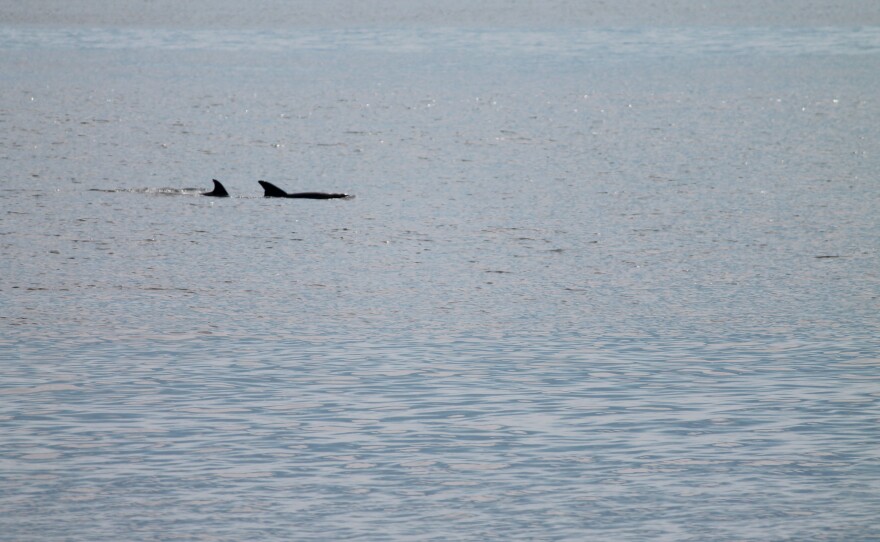Preliminary numbers from an annual dolphin count Saturday give hope that the Atlantic Bottlenose Dolphin population is rebounding.
The Atlantic Bottlenose Dolphin comes north to spend summers along the Delaware coast, attracted by an abundant food supply that sustains their ecosystem.
“They are seeking food, they’re teaching their young how to feed, but they also love the currents and waves and they will ride waves just like people do on a raft or a surfboard,” said Suzanne Thurman, the executive director of the Marine Education, Research and Rehabilitation Institute, or MERR Institute.
Thurman said dolphins follow their prey — crustaceans, squid, fish that have a high fat content — along the Atlantic coast.
A bottlenose dolphin has a protruding beak and a very round bulbous melon on its forehead – two traits that distinguish this particular dolphin species. They’re one of a few animals that play just for the sheer enjoyment of it.
But the bottlenose dolphin has struggled to bounce back from the 2010 Gulf of Mexico oil spill and a morbillivirus that targeted marine life and spread through the population. This virus, affecting the lungs, brain and the immune system, previously impacted members of the dolphin population in the late 1980s.
“We expected to see a decline, and indeed we saw a decline in our annual dolphin count the past two years,” Thurman said.
MERR saw just seven dolphins at Herring Point in Cape Henlopen State Park in 2015, concluding that the dolphins were still suffering the aftermath of the virus.
Having helped out with the count since 2014, MERR volunteer Craig Marker said he has noticed the decline, but, with evidence of dolphin sightings, a population surge could happen this year.
“This is the first year we’ve had the opportunity to see dolphins at the count,” said Marker, who was stationed at sites where he saw no dolphins in previous years. “So even though we didn’t count dolphins the last two times, we recorded that there wasn’t dolphin activity and they could gauge where the dolphins’ activity was along the Delaware coast.”
Saturday, Thurman and several MERR volunteers counted 36 bottlenose dolphins at Herring Point, which was one of over 30 observation points from Fenwick Island to Woodland Beach. Data from the other observation points have not come back yet, but with better numbers at Herring Point in comparison to last year, MERR is optimistic, Thurman said.
"But it is too soon in the cycle of things to know if their population is bouncing back because any young born last year will take a while to reach reproductive maturity," Thurman said.
For females, reproductive maturity is seven to 13 years old. For males, it is nine to 13 years old.
“We’ve got a nice group coming through here,” Thurman said, acknowledging the population count on Satuday. “Most of them are going north, but I just saw one circle back. That means there are probably some fish or they’ve got a young one in the circle in the midst.”
MERR used the count to examine patterns impacting the dolphin sightings: For example, a seagull diving down indicates food, while a boat nearby often causes dolphins to flee.
“Along with that, we try to see how many babies there are and then just take down any interference through human interaction,” MERR volunteer Andrew Aufdemberg said. “Like boats, along with the fish activity and bird activity, to figure out whether they’re feeding or not at this time.”
Everybody gets excited when they see a dolphin at the ocean because you see them on the television or at a local aquarium and they're very attractive animals. -MERR volunteer Craig Marker.
So what makes the Atlantic Bottlenose Dolphin such a treasure? Marker said there is a natural attraction between humankind and the playful mammal.
Marker said. “They seem to like human interaction, so I think as humans we’re attracted to them, so it’s neat to come to the ocean and actually see them in their own environment.”
Thurman said their features and their intelligence, among many other traits make them beloved by mankind.
“I think the dolphins are just beloved in general,” Thurman said. “They’re very present, they’re great ambassadors for all of the species. Their features make them look like they have a built-in smile. They’re known to be highly intelligent, communicative and very social. So, because we in Delaware can come to the beach on any given day and see them from the shore, (it) makes them seem so present in our lives.”
If an ample amount of dolphins are seen during the count, it’s a sign of a healthy marine ecosystem, good ocean health and water quality, Thurman said. For seafood lovers, a healthy fish stock means an adequate amount of food coming from the ocean and onto the plate.



